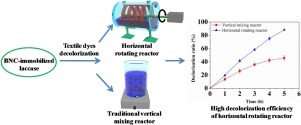当前位置:
X-MOL 学术
›
Biochem. Eng. J.
›
论文详情
Our official English website, www.x-mol.net, welcomes your feedback! (Note: you will need to create a separate account there.)
Enhanced decolourization efficiency of textile dye Reactive Blue 19 in a horizontal rotating reactor using strips of BNC-immobilized laccase: Optimization of conditions and comparison of decolourization efficiency
Biochemical Engineering Journal ( IF 3.9 ) Pub Date : 2020-04-01 , DOI: 10.1016/j.bej.2020.107501 Haibin Yuan , Lin Chen , Zhangjun Cao , Feng F. Hong
Biochemical Engineering Journal ( IF 3.9 ) Pub Date : 2020-04-01 , DOI: 10.1016/j.bej.2020.107501 Haibin Yuan , Lin Chen , Zhangjun Cao , Feng F. Hong

|
Abstract The textile dyeing and printing industry has led to extensive environmental pollution and severely threatens ecosystems. Immobilized laccase (IL) is an effective biocatalyst for the biotreatment of dye effluents, but is usually restricted by its aerobic requirements. Thus, it is desirable to design an efficient reactor that will increase the applicability of IL on an industrial scale. Decolourization efficiency of Reactive Blue 19 (RB 19), selected as a model textile dye, was compared between a horizontal rotating reactor (HRR) and a traditional vertical mixing reactor (VMR). The HRR was equipped with strips of bacterial nanocellulose (BNC) immobilized laccase, and the VMR contained wafers of BNC immobilized laccase. The maximum decolourization efficiency of HRR was achieved at the optimized temperature of 55°C, pH of 4.0, and agitation speed of 20 rpm. Advantages of HRR over VMR include a broader range of enzymatic reacting temperatures, greater contact and reacting interfacial area, and higher oxygen availability. After reacting RB 19 at optimized conditions for 5 h, the decolourization ratios of the VMR and HRR were, respectively, 45.7 % and 88.2 %. The HRR provided greater reusability of immobilized enzyme and higher detoxification, removal of chemical oxygen demand and total organic carbon, indicating great potential in promoted decolourization of dyeing effluents.
中文翻译:

使用 BNC 固定化漆酶条提高水平旋转反应器中纺织染料活性蓝 19 的脱色效率:条件优化和脱色效率比较
摘要 纺织印染业造成了广泛的环境污染,严重威胁着生态系统。固定化漆酶 (IL) 是一种用于染料废水生物处理的有效生物催化剂,但通常受到其需氧要求的限制。因此,需要设计一种有效的反应器,以提高 IL 在工业规模上的适用性。在卧式旋转反应器 (HRR) 和传统立式混合反应器 (VMR) 之间比较了被选为模型纺织染料的活性蓝 19 (RB 19) 的脱色效率。HRR 配备有细菌纳米纤维素 (BNC) 固定化漆酶条,VMR 包含 BNC 固定化漆酶晶片。HRR 的最大脱色效率是在优化温度 55°C,pH 值 4.0,和20转/分的搅拌速度。HRR 相对于 VMR 的优势包括更广泛的酶反应温度范围、更大的接触和反应界面面积以及更高的氧气可用性。RB 19 在优化条件下反应 5 h 后,VMR 和 HRR 的脱色率分别为 45.7% 和 88.2%。HRR 提供了更大的固定化酶的可重复使用性和更高的解毒、去除化学需氧量和总有机碳,表明在促进染色废水脱色方面具有巨大潜力。45.7% 和 88.2%。HRR 提供了更大的固定化酶的可重复使用性和更高的解毒、去除化学需氧量和总有机碳,表明在促进染色废水脱色方面具有巨大潜力。45.7% 和 88.2%。HRR 提供了更大的固定化酶的可重复使用性和更高的解毒、去除化学需氧量和总有机碳,表明在促进染色废水脱色方面具有巨大潜力。
更新日期:2020-04-01
中文翻译:

使用 BNC 固定化漆酶条提高水平旋转反应器中纺织染料活性蓝 19 的脱色效率:条件优化和脱色效率比较
摘要 纺织印染业造成了广泛的环境污染,严重威胁着生态系统。固定化漆酶 (IL) 是一种用于染料废水生物处理的有效生物催化剂,但通常受到其需氧要求的限制。因此,需要设计一种有效的反应器,以提高 IL 在工业规模上的适用性。在卧式旋转反应器 (HRR) 和传统立式混合反应器 (VMR) 之间比较了被选为模型纺织染料的活性蓝 19 (RB 19) 的脱色效率。HRR 配备有细菌纳米纤维素 (BNC) 固定化漆酶条,VMR 包含 BNC 固定化漆酶晶片。HRR 的最大脱色效率是在优化温度 55°C,pH 值 4.0,和20转/分的搅拌速度。HRR 相对于 VMR 的优势包括更广泛的酶反应温度范围、更大的接触和反应界面面积以及更高的氧气可用性。RB 19 在优化条件下反应 5 h 后,VMR 和 HRR 的脱色率分别为 45.7% 和 88.2%。HRR 提供了更大的固定化酶的可重复使用性和更高的解毒、去除化学需氧量和总有机碳,表明在促进染色废水脱色方面具有巨大潜力。45.7% 和 88.2%。HRR 提供了更大的固定化酶的可重复使用性和更高的解毒、去除化学需氧量和总有机碳,表明在促进染色废水脱色方面具有巨大潜力。45.7% 和 88.2%。HRR 提供了更大的固定化酶的可重复使用性和更高的解毒、去除化学需氧量和总有机碳,表明在促进染色废水脱色方面具有巨大潜力。



























 京公网安备 11010802027423号
京公网安备 11010802027423号